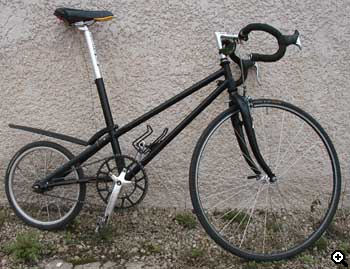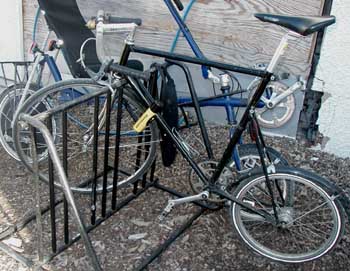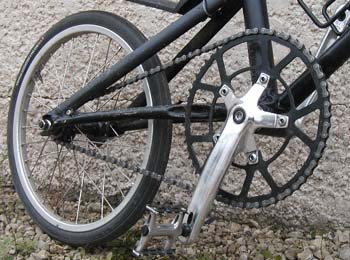[ 63XC.COM | STORIES | ART SCHOOL ]
Enter the Art School It is to exist between worlds. I work at a thriving recumbent shop, but I ride a fixed wheel almost everywhere I go. Thus did I build the Warbike, a fixed short wheelbase. I'd been shown a picture of a fixed LWB from the 1920s, but this appeared to be the only precedent. This added to the excitement. I really wanted it to work. It did not, sadly. Not for the fast-traffic commuting purposes I'd had in mind, at least. It was another of those rides that would be great fun if the cars went away. Riding the Warbike meant sitting on top of the drive wheel. Lifting the frame to kick a pedal into position was not easy. Especially with cargo. I fell over sideways at intersections a few times, which got to be a drag. I set the idea aside, pending a proper re-work perhaps. I'd learned what I needed to, in the meantime: the small drive wheel kicks ass, for fixed. Starts and stops much more easily, even with bigger gears. I settled eventually upon a 58t ring paired with a 13t cog, which on the Warbike's 20"/406 drive wheel translated as a gnarly 83-inch gear. The wheelset might have been the coolest thing about it, actually. First keys to the big mystery. A BMX frameset abandoned in the yard inspired the transition to upright cycling. This was even cooler. That fall I put together a basic cromoly 20" fixed frameset. It took a tip from the folders, incorporating a taller free-standing seat pillar. The bike was finished just in time for winter. I quickly discovered how it dealt with the snow. It didn't. The small front was just not the thing. The snow sometimes consumed half the front wheel and more, and the design's longish steerer tube only added to the abstraction. It's sometimes very useful to have a shovel for getting through snow. My shovel was suddenly much too small, with a handle far too long. A big spoon maybe. I've biked through about 14 upper Midwest winters, four of those as a Minneapolis courier. I always used to ride thin road wheels through the winter. Downtown, at least, where the more extensive snow-plowing made for the sketchy cookie-cutter snow we learned to thrive upon. (More recently I've been discovering how big 26" knobbies are somewhat better for the city's more outlying hinterlands. But, whatever... the effective geometry is actually pretty damned similar. It's easy enough to swap out a front end for the winter.) The sum of things led to Patches, a further bike, cobbled together from various dead frames. It paired a thin 700c front wheel to a 20" fixed rear. I was only curious to see if it could be done, and I was none too surprised when the quick construction began to fail some weeks later. But I'd again learned just enough. This was also something cool. Others were less sure. "What the hell is that thing?!" was a typical reaction. And so I began calling it an Art School Bike. This from a Midwestern appreciation of what some know as the art school style, with the hair long in front and short in back. Like the Cure or something. (Those choppers and recumbents with smaller front wheels, of course, could be called Mullets. Or maybe Hockey Hair Bikes or Ape Drape Machines, depending.) The first proper art school bike came together on the back of an old road frame. I was able to leave the front triangle alone, only modifying the back end to fit the smaller wheel. The chainstays were simply chopped off and re-attached at better angles. Bike #4, as it came to be known, did much better than Patches. My traffic profile shrank just enough to allow for some more daring escapes. And, since it was fixed, the small wheel's notorious tendency to shed speed began and ended as a non-issue.
I came away with only a pair of smaller problems. The smaller rear wheel trapped beneath the regular-sized front triangle made for a fairly harsh ride, and the particular way I'd put it together made for a persistent creaking. I'd re-used the bikes original seatstays as with the front triangle, the pair had already been connected by professionals and the drastically new geometry found them meeting the seat tube around halfway up. The creak could not be reliably traced to any of the bikes components. It seemed structural. My hunch was that a return to the free-standing seat pillar would solve everything. Thus do we arrive in the present, astride the newest and coolest Art School Bike, #5. It was supposed to become the ne plus ultra of the type. (But such a forecast only comes to poetic angst; it doesn't mean anything at all.) The bike is all I'd hoped for: lighter, faster, more comfortable, but it still leaves certain room for improvement. As with its older peer, #5 grew from an existing road frame. The lower front portion only, this time: the head tube sat at precisely correct angles to the bottom bracket lug. I still have no access to regular frame-building jigs or anything complicated like that, so borrowing from the factory's precision saved a good deal of time. The seat tube, an 18" length of sturdy cromoly tubing obtained from an aircraft supply place out East, featured interior dimensions which matched our local wholesalers largest available seat tube. 31.8mm. The bike's top tube was filled in with some lightweight bike tubing we had laying about. The seatstays were fashioned from aero-section cromoly for similar reasons. The head tube was milled to fit this fork I was keen on, an old Cannondale Pepperoni aluminum job. I'd thought it would look cool wrapped around a thin road tire. A road caliper brake, of course, was able to fit neatly through that central hole previously reserved for fender hardware. I always run a front brake, unlike most other fixie riders in my know. I'm also the only oneto recover from a bicycle-induced massive head trauma, so whatever, it's cool. (I also rock the stylish Fusion helmet, I just dont give a fuck.) #5 is, most definitely, the best so far. It pairs the 700c front to a 16/349 rear. Schwalbe recently made available a slick little Stelvio tire for the latter. Thus far it's done really well. I still keep meaning to take notice of my small wheel's alleged fault, the short attention-span, but I haven't really picked up on it. As if the mix-and-match effect blurs our precious distinctions. I have not yet put in any longer rides on #5, but I didn't really intend to. I already have a wonderful old tour bike; this wasn't what I had in mind.
Set up on the new bikes 16/349 rear wheel, the 58/13 combination makes for an especially comfortable 71-inch gear. Quick starts, handy stops, fast like a cat. My rain bike is an old Schwinn fixed roadie, geared also in the low 70s, and in switching back and forth the new bike comes off as appreciably more entertaining. I was on this very rain bike today, actually, and the art school's success was suddenly drawn into relief: it is much easier to control. The small back is the main thing, obviously, but the drastically shortened chainstays and wheelbase certainly make positive contributions. I was originally wanting more of an advantage against the ever more overbearing motor traffic, and I'd swear this is what I've found. Were there occasion for moralistic considerations I might describe the improvement as something like cheating. I had wondered about keeping the front wheel reliably upon the ground, with the shorter rear triangle, but this has not really come up. I do ride my handlebars low; this is probably more important with the art schools. Mechanically, I notice two other tendencies particular to these bikes. The chainring bolts come loose more often, and the chain tension fades a bit easier as well. I might set up some BMX chain tensioners, but I'm less interested in thread-locking my chainring bolts. We'll see. I'm not sure the advantages of the design could be fully enjoyed by a freewheel bike, incidentally. The incremental losses in efficiency would compound each other; this particular game only really wins on the fixed wheel. That said, I do realize my interests here plow on in spite of more marketable pursuits. The small wheels profitable mixture with the fixed might best be described as counterintuitive. So yeah, you know, welcome to the art school. I really think large and small wheels each have their own inherent values. I already hope to build a successor. #6. The present bike really is close to ideal, but the design could stand to lose 2 or 3 inches off the tail end. Traction would be further enhanced, and my profile become smaller yet. I also hope to use a proper frame tubing kit, which is probably about due. The focus is probably kept fairly specific, as it has been, but this only confirms their standing as specialists. Paladins, magicians, doctors. I aspire to refine the concept as I'm able to; who knows what will happen. Further updates on this and a great many other things may be pursued in 'Speed Metal', the updated and greatly expanded follow-up to 'How to Rock and Roll', forthcoming at a future point. [ TOP ] |
Writer
Sam Tracy is the author of 'How To Rock And Roll', an alt. bike manual that should be on your bookshelf.
Date
v1.0 written May 2003
Related
Buy 'How To Rock And Roll' here.
Junzo 'Suntour' Kawai's MTB Hall of Fame entry clearly shows an 80s art school bike. We asked you to help identify it. David Whittam wrote to say that it was made by Charlie 'WTB' Cunningham, and that Charlie is the one in the puffa jacket.
Mailing list
Join the 63xc.com list.


